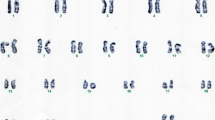Summary
A family with G-ring mosaicism in two generations in presented. The index patient has the chromosome constitution: G-ring / G-monosomy. His mother, brother and maternal uncle are mosaics with 3 cell lines: Normal (predominantly) / G-ring (few) / G-monosomy (few). The index patient presents with small stature (below 3rd percentile) and mental retardation, his mother, brother and uncle are clinically normal individuals except for some minor degenerative signs. The lack of similarity between the phenotypes of the index patient and of other carriers of a G-ring from the literature does not seem to justify the assertion of a new syndrome.
Zusammenfassung
Das familiäre Vorkommen eines G-Rings in Mosaikkonstitution zweier Generationen wird beschrieben. Der Proband stellt ein Mosaik mit der Formel G-Ring/G-Monosomie dar. Seine Mutter, Bruder und Onkel mütterlicherseits sind Mosaikkonstitutionen mitden Zellinien: Normal (überwiegend) / G-Ring (schwach) / G-Monosomie (schwach). Der Proband ist geistig retardiert und klein gewachsen (unter der 3. Perzentile), die übrigen Mosaikindividuen sind bis auf wenige pathologische Züge klinisch unauffällig. Der Merkmalsvergleich zwischen dem Probanden und den anderen, in der Literatur beschriebenen Fällen von G-Ring-Trägern zeigt, daß die Phänotypen dieser Individuen jene Ähnlichkeiten vermissen lassen, welche die Aufstellung eines Syndroms rechtfertigen würden.
Similar content being viewed by others
Literatur
Abbo, G., H. Zellweger, and R. Cuany: Satellite association (SA) in familial mosaicism. Helv. paediat. Acta 21, 293 (1966).
Atkins, L., R. T. Sceery, and M. E. Keenan: An unstable ring chromosome in a female infant with hypotonia, seizures and retarded development. J. med. Genet. 3, 134 (1966).
Bain, A. D., I. K. Gauld, and J. W. Farquhar: A ring X chromosome in dwarfism. Lancet 1965 I, 820.
Benson, P. F., A. S. Taylor, and M. H. Gough: Chromosome anomalies in primary. lymphoedema. Lancet 1967 I, 461.
Bishop, A. M., C. E. Blank, K. Simson, and C. J. Dewhust: An XO/X ring X chromosome mosaicism in an individual with normal secundary sexual development. J. med. Genet. 3, 129 (1966).
Blank, C. E.: Some aspects of chromosome mosaicism in clinical medicine. Lancet 1964 II, 903.
Braver, G., and J. L. Blount: Somatic elimination of ring chromosome in Drosophila melanogaster. Genetics 35, 98 (1950).
Challacome, D. N., and A. Taylor: Monosomy for a G autosome. Arch. Dis. Childh. 44, 113 (1969).
Darlington, C. C.: Recent Advances in Cytology. 2nd ed. London: Churchill 1937.
Di Grado, F., F. T. Mendes, and E. Schroeder: Ring chromosome in a case Di Gugliemo syndrome. Lancet 1964 II, 1243.
Engel, E., C. P. Hastings, R. E. Merrill, B. S. McFarland, and M. E. Nance: Apparent cri-du-chat and antimongolism in one patient. Lancet 1966 I, 1130.
Gerald, P. S., Ch. Davis, B. M. Say, and J. L. Wilkins: A novel chromosomal basis for imperforate anus (the cat's eye syndrome). Pediat. Res. 2, 297 (1968).
Hoefnagel, D., T. M. Schroeder, K. Benirschke, and F. H. Allen Jr.: A child with a group-G ring chromosome. Humangenetik 4, 52 (1967).
Hooft, C., P. Haentjens, E. Orye, P. Kluyskens et G. D'Hont: Chromosome 18 en anneau. Acta paediat. belg. 22, 69 (1968).
Jagiello, G. M.: Familial 13–15 translocation abnormality (Denver classification) associated with one case of cerebral palsy. New Engl. J. Med. 66, 269 (1963).
Lejeune, J., R. Berger, O. M. Réthoré, L. Archambault, H. Jérôme, S. Thieffry, J. Airardi, M. Broyer, J. Lafourade, J. Cruveller et R. Turpin: Monosomie partielle pour un petit acrocentrique. C. R. Acad. Sci. (Paris) 259, 4187 (1964).
—: De la duplication de structures circulaires. Ann. Génét. 11, 71 (1968).
McIlree, M. E., S. W. Tulloch, and J. E. Newsam: Studies on human meiotic chromosomes from testicular tissue. Lancet 1966 I, 679.
Migeon, B. R.: Familial variant autosomes: New human cytogenetic markers. Bull. Johns Hopk. Hosp. 116, 396 (1965).
Morgan, L. V.: A closed X chromosome in Drosophila melanogaster. Genetics 18, 250 (1933).
Navashin, M.: Chromosomal variegation in C. tectorum. Univ. Calif. Publ. Agr. Sci. 6, 99 (1930).
Penrose, L. S.: Anti-Mongolism. Lancet 1966 I, 497.
Reisman, L. E., S. Kasahara, C. Y. Chung, A. Darnell, and B. Hall: Anti-Mongolism. Studies in a infant with a partial monosomy of the 21 chromosome. Lancet 1966 I, 394.
—, A. Darnell, J. W. Murphy, B. Hall, and S. Kasahara: A child with partial deletion of a G-group autosome. Amer. J. Dis. Child. 114, 336 (1967).
Schachenmann, G., W. Schmid, M. Fraccaro, A. Mannini, L. Tiepolo, G. P. Perona, and E. Sartori: Chromosomes in coloboma and anal atresia. Lancet 1965 II, 290.
Schwarzacher, H. G., u. W. Schnedl: Autoradiographische Untersuchungen über die Endoreduplikation. Naturwissenschaften 52, 23 (1965).
Shaw, M. W.: Familial mongolism. Cytogenetics 1, 141 (1962).
Smith-White, S., W. J. Peacock, B. Turner, and G. M. Den Dulk: A ring chromosome in man. Nature (Lond.) 197, 102 (1963).
Sparkes, R. S., R. E. Carrel, and S. W. Wright: Absent thumbs with a ring D 2 chromosome: A new deletion syndrome. Amer. J. hum. Genet. 19, 664 (1967).
Steele, M. W., W. R. Breg, A. I. Eidelman, D. T. Lion, and T. A. Terzakis: A B-group ring-chromosome with mosaizism in a newborn with cri-du-chat syndrome. Cytogenetics 5, 419 (1966).
Szekely, O., L. Laszlo, G. Földese J. Seregi: Sindrome di Turner diagnosticata in età infantile. Min. pediat. 20, 303 (1968).
Turner, B.: Cytogenetic studies in mental retardation. Proc. Aust. Ass. Neurol. 1, 41 (1963).
Weleber, R. G., F. Hecht, and R. E. Giblett: Ring-G chromosome, a new G-deletion syndrome? Amer. J. Dis. Child. 115, 489 (1968).
Wolf, Ch. B., J. A. Peterson, G. A. LoGrippo, and L. Weiss: Ring 1 chromosome and dwarfism—a possible syndrome. J. Pediat. 71, 719 (1967).
Zellweger, H.: Familial chromosomal aberrations. Part II. Ann. paediat. (Basel) 206, 380 (1966).
Author information
Authors and Affiliations
Rights and permissions
About this article
Cite this article
Zdansky, R., Bühler, E.M., Vest, M. et al. Familiäres Mosaik mit G-ring. Hum Genet 7, 275–286 (1969). https://doi.org/10.1007/BF00283550
Received:
Issue Date:
DOI: https://doi.org/10.1007/BF00283550




